Just a little post-edit remark – I’ve noticed that this particular blog post seems to be getting hits every day and I’m not sure why. Is it from people doing a google search for Bramshott, or has my post been linked some place? I’d love to know why. So if you have just happened upon this post, would you mind letting me know how you came upon it, either in the comments section, or by emailing me at kelownagurl at gmail dot com. Even if the post was not what you were looking for! Thanks!
*****
We had a great nine hour flight via Westjet, direct from Calgary, and were lucky to be able to book the bulkhead seats on this trip so Erik had plenty of leg room. The only downside to our flight was was arriving at 10am (body time 2am), but our hosts at the Gatwick House B&B in Horley, which is only a 5 minute bus ride from Gatwick, graciously allowed us a very early check in and we went straight to bed around noon, for a 3 hour nap. We dragged our butts out of bed, had an early dinner and forced ourselves to stay awake until 8pm. We had a fitful 11 hour sleep but awoke feeling fairly refreshed, albeit a bit buzzed. Ah jet lag, I do not love you.
And so, after a “Full English Breakfast” for Erik and yogurt and toast for me, our hosts drove us back to the airport where we picked up our rental car and hit the road. We had a 4 hour drive to Plymouth, on the outskirts of Cornwall, with one planned stop in Bramshott, Hampshire, along the way.
Bramshott is a small village about an hour’s drive southwest of London and was the site of two military camps in WW1 and WW2 – Bramshott Camp and Bordon Camp. It was here that many Canadian soldiers trained during the war before being sent to the front. I decided to visit the village because my Dad’s father, Robert Fleming Park, had been stationed here near the end of WW1 and I really wanted to see where he had lived for the 15 months he was in England. And when I looked at the map and saw that the village was practically along the route for our drive, I couldn’t resist.
As we first neared the village, we drove along the Canadian Memorial Drive which is lined with Maple trees. We stopped to see if we could find the memorial stone, but it didn’t seem to be evident, so we drove a little further on to the church. The sites of the camps themselves are nothing more than old roads and overgrown grass and bushes now, with all signs of buildings having been long removed. However, there is a memorial stone and quite a bit of info both inside St Mary’s church and outside in the cemetery.
The No 12 Canada General Hospital served the area, and 318 Canadian soldiers are buried in the St Mary churchyard. Some of them died from wounds received in battle, but most had survived the war, only to succumb to the 1918-1920 Spanish Flu pandemic that infected over 500 million people worldwide, killing 50-100 million people (3-5% of the world’s population). 187 Canadian soldiers were buried at St Mary’s in 1918 alone and most of those young men died of the flu.
As I looked through my Grandfather’s military records (available online at the Canadian Archives) , I could see a number of things had occurred that would enable my grandfather to return home to marry my grandmother, and ensure my father was born. If things had gone differently, I may never have been born!
The Canadian government brought in the Military Service Act in August of 1917, after much debate, which required that all able bodied men from 20-45 serve in the military if called. My grandfather, born in 1897, turned 20 that very month, and so I’m sure he expected to be called up soon. I only knew him as an older man, and he always seemed very quiet, peaceful, and devout, and I had a hard time imagining that he would have wanted to go to war. However, after he finished school, he served six months in the 6th Regiment D.C.O.R. (Duke of Connaught’s Own Rifles) in Vancouver (January-June of 1917) while working as a telegrapher, followed by 5 months in the Railway Service Guard in Vancouver. On December of 1917, he had his military medical exam and was called up on January 3, 1918 to the 1st depot Battalion for training at the Drill Hall in Vancouver.
His personnel records are really interesting to read, as they include many details on his physical stature, weight, and medical and dental health. He was healthy and categorized as A2 “fit for despatching overseas”, although it was noted that he had enlarged tonsils, a fact which would come in play later.
In April he was transferred to the 68th Battery and in June 1918, he set sail on the troop ship, SS Waimana, for England. Luckily, this was only about four months before the end of the war, so he would never be sent to the front.
I’m not sure where the ship landed but Robert spent the next few months training as a gunner at Witley Camp, SE of London. After the war ended five months later on November 11, 1918, he was transferred to Camp Bordon and Camp Bramshott, where he work as a driver for the records office. During his short term in the military, I suspect he likely used his skills as a telegrapher.
It was during this time that so many young soldiers were becoming ill and dying of a virulent form of influenza that seemed to prefer healthy young people. The bug got into their lungs and most died of pneumonia within a few days.
Although the war was now officially over, there was still work to be done and my Grandfather wouldn’t be demobilized until the following year. However, in March of 1919, he was admitted to the Canada General Hospital in Bramshott with bronchitis and tonsillitis. His medical records indicate his fever was as high as 103* at time.
He remained in hospital for ten days before being transferred to a larger hospital in Orpington, southeast of London, where he had a tonsillectomy and spent another month recovering. He was finally discharged in June 1919 and sent back to Bramshott where he served out the rest of his tour. On August 9, 1919, he embarked on the SS Cassandra back to Canada (train to Vancouver), and he was discharged from the army on Aug 25, 1919.
And so now I found myself walking through St Mary’s church cemetery in Bramshott, looking at all of the young soldier’s gravestones, each marked with a Maple Leaf. The cemetery is kept pristine, with the grave markers lined up perfectly, and the lawn around them carefully mowed. I wondered how many of these men were friends or colleagues of my grandfather and what it must have been like to attend a burial almost every day.
As we walked through the cemetery, a woman approached us on her way through. We explained why we were there and she told us how important the Canadian soldiers were, and still are, to the people of the area. She explained how even now, on the Wednesday closest to Canada Day (July 1), the local school has each student adopt a soldier’s grave, tidy it, and place a Canadian flag on each grave. Then the community members have a ceremony and sing O Canada. It was really touching to hear the reverence in her voice as she talked and I’ll admit I was choked up, with tears in my eyes. And as I looked at the ages on the markers, so many just around 20, I tried to imagine having to send my now-19 year old son to war. I couldn’t fathom it.
The woman encouraged us to look at the memorial items inside the church as well, and we saw that many of the pew cushions were embroidered with Canadian flags and other symbols such as moose and beaver and provincial flowers. There were Canadian flags all over, and at least one stained glass window with pane for each province. It was incredibly moving to think of the importance the local people still place on our soldiers, even 100 years later.
Next summer, it will be 100 years since my Grandpa arrived for his short stay in the military camps in the area. I am so thankful that the war ended so soon after he arrived, and that he did not succumb to the Spanish Flu while he was ill. With only a few changes to his life’s plan, he may never have returned to Canada to marry my Grandmother 10 years later, and my father may never have been born.
And so we took one last look around at the churchyard, drove slowly past the now empty fields where the camps and hospital had been located, and set off for our next stop – Plymouth, England, where the Mayflower stopped before her voyage to the new world in 1620.
Next up: Cornwall
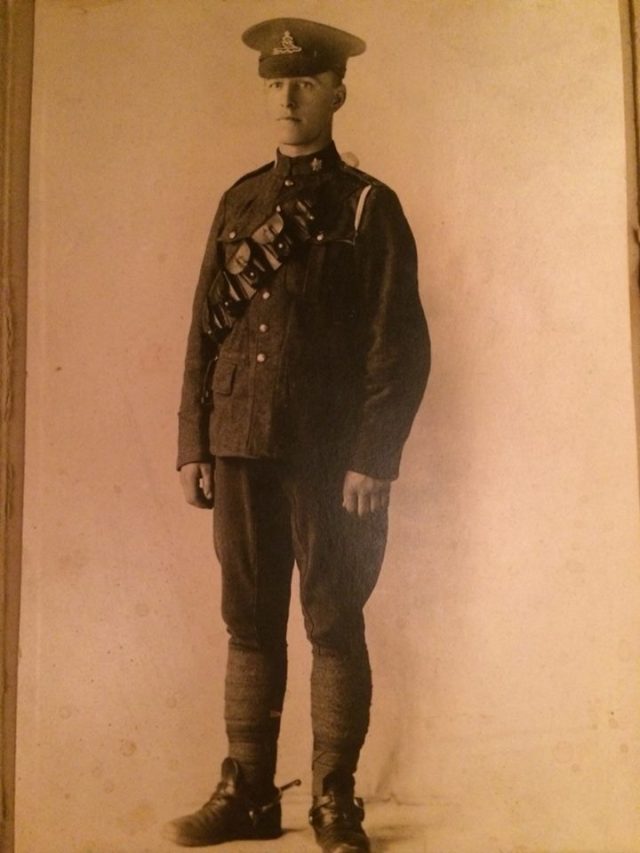

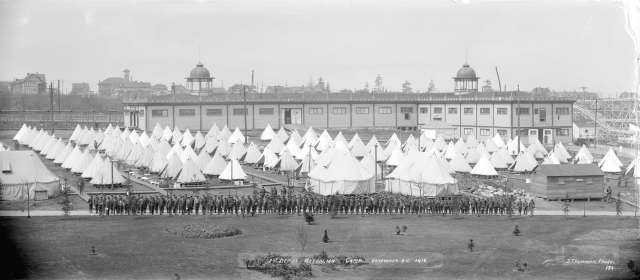
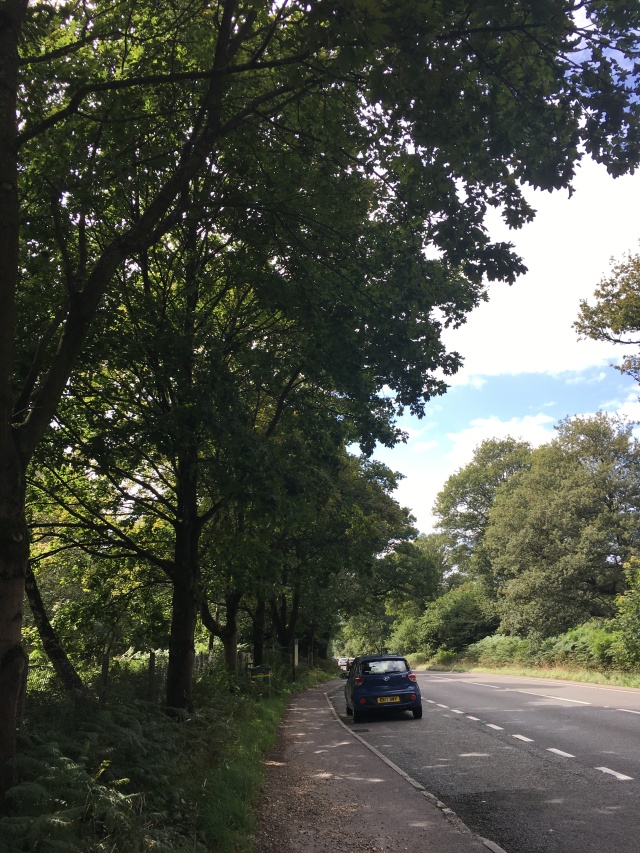
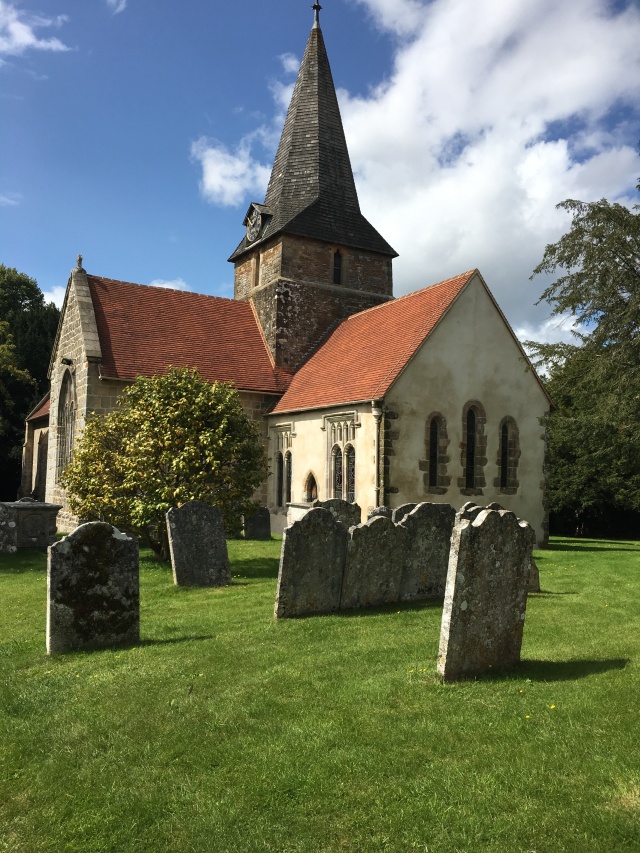
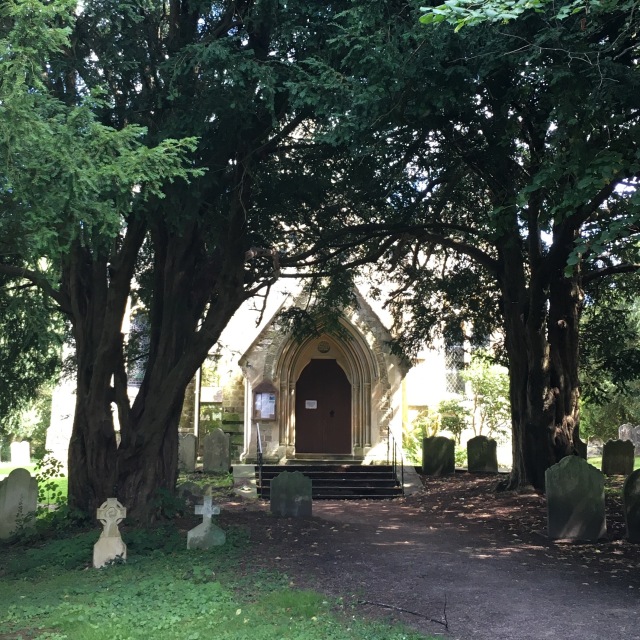

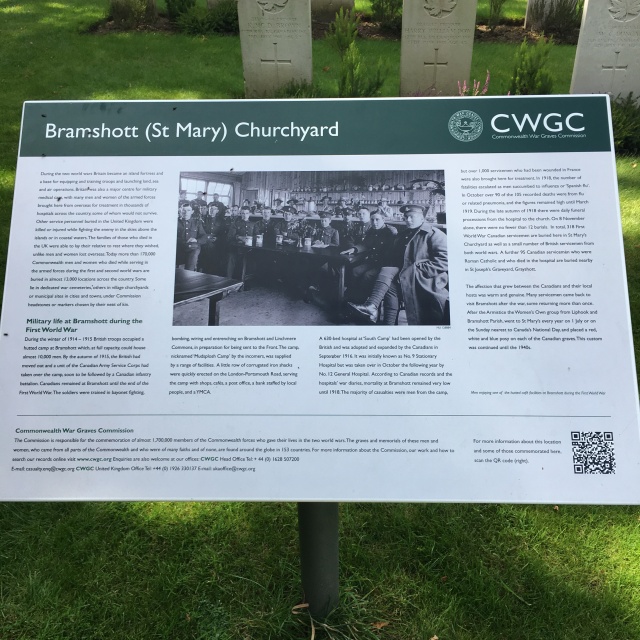
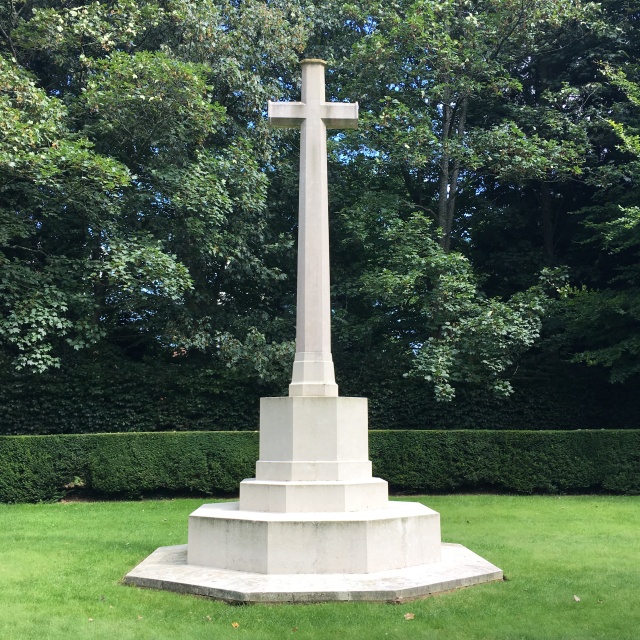

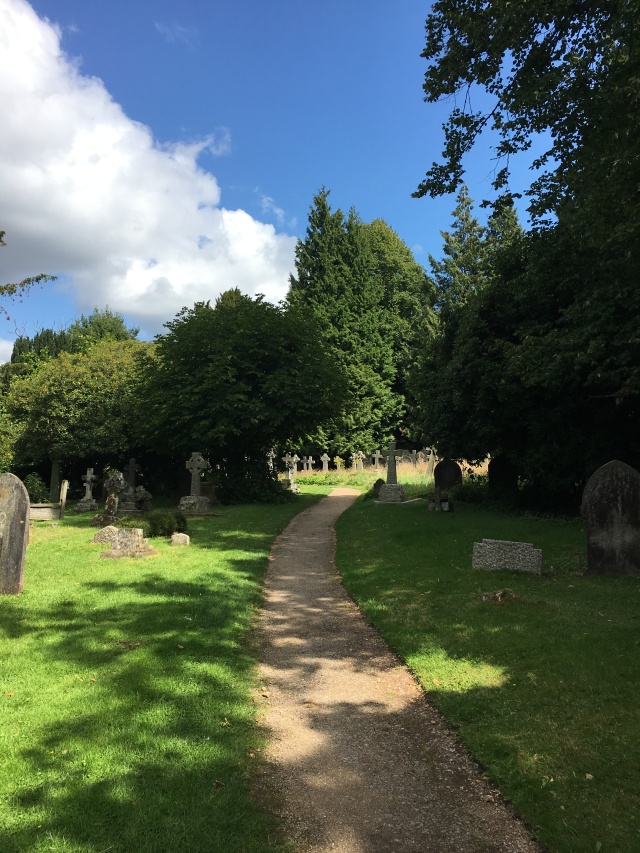

Very impressive. Thanks to grandpa for you!
LikeLiked by 1 person
Thank you for the info. Was doing some research as my grandfather was posted at Bramshott during WWI and as it turns out my father was actually born there.
LikeLiked by 1 person
Oh wow, that must have been interesting to learn!
LikeLike
Thanks for this. Googled bramshot camp as we have a letter from there from my husband’s great grandfather to his son sent 2 months before he was killed in Belgium in ww1. He served with the Canadian army although he was born and married in Glasgow
LikeLiked by 1 person
Wow I would love to find some letters my grandfather wrote home during the war.
LikeLike
I sure wish I had some letters my grandpa had written home. I do have letters he wrote later in life and can tell his letters from WW1 would have been interesting to read. Thanks for your comment and sorry for the late reply!
Edited to add – oh, I DID reply. Haha.
LikeLike
Found your blog looking for info on Bramshott. Thanks for documenting your trip and for the great photos. My grandfather was stationed there and in Folkestone during WWI. I have several postcards and letters he sent to his future wife, my grandmother, while he was there. We will be visiting the area in two weeks and I hope to donate his postcards to a local museum. Would be happy to scan and send you the postcards if you are interested in seeing them….just email me.
Mary Beth MacKenzie
Maple Bay, BC CANADA
mbmackenzie at shaw dot ca
LikeLiked by 1 person
Thanks for your kind comments and glad the photos were of interest. I am interested in your postcard and have emailed you. 🙂
LikeLike
Found your blog when looking for info and pics of my great uncle Pte 1716 Murdoch Nicolson (some records spelt Nicholson) Highland Light Infantry who trained at Bordon & then Bramshott. I’ve picked up a lot of info from the various websites but no photo’s of him or his battalion or company. He was killed in action 25th September 1915 at the Battle of Loos. Great info and pics btw!
LikeLiked by 1 person
Thanks so much for your comment, William. Sad to hear your great uncle was killed in battle and too bad you don’t have any photos. I too have spent a lot of time on various websites looking for info. The best thing I found was my grandpa’s full WW1 records on the Govt of Canada website. Super interesting reading.
I’m glad you found my post interesting. Good luck on your searching!
LikeLike
Well what do you know…. 2 weeks after returning home from a visit to France and an in the footsteps tour of the front line where my great uncle was killed a photo of him as a schoolboy turned up in an archive centre local to where he lived, 1600 photos and head spinning there he was confirmed in the school register and log book and each pupil named in the photo. The very next day my aunt discovered a photo of him with my grandfather who I was very close to as a child and young adult. Having this restored and enhanced for his medal display, Unreal how this panned out! Moral of this story is keep looking close to home with family the best option.
LikeLike
My great grandfather was stationed at Bramshott Camp during WW1, sadly he never returned home.
Found you blog while searching for Brampshott after finding it on a letter he wrote home.
Thank you for the information you have provided here.
LikeLiked by 1 person
I came across this blog post while researching my great- grandfathers time stationed there during WW1.
Thanks for the photos and details- it made everything much more real for me.
LikeLike
Glad it was helpful! It’s so nice to be able to visit some of these sites when researching family history. Happy to share!
LikeLike
See my previous comment above. This is my Great Uncle Pte 1716 Murdoch Nicolson B Coy 10th Battalion Highland Light Infantry
https://www.pressandjournal.co.uk/fp/news/islands/1885159/the-forgotten-man-of-skye-war-hero-to-be-remembered-for-first-time-by-family/
LikeLike
Found this site whilst googling “WW1 Bramshott Segregation Camp” – thanks it was very informative and interesting. Alfred STIMPSON b. Sutton Ely Cambridgeshire emigrated to Canada, joined the CEF in 1915, sailed to Liverpool and was sent to Bramshott Camp.
LikeLike
Found your site while looking for the Bramshott Imperial Hospital where my wife’s grandfather James Arthur Pyne Jr. spent time in during WW1. He joined the Brockville Rifles in 1915 and was shipped over in May of 1916. He was there in the hospital 2 times in the summer of 1916 and again in the fall until he was shipped back to Canada in January 1917, where he spent the year in Kingston, Ontario recovering. Thanks for the information.
LikeLiked by 1 person
when i was reading my grandfathers ww1 records it mentioned Bramshott camp. He was transfered to England aboard the Saxonia in April 1917 from Halifax Nova Scotia. He retured home in 1918. Thank you for the information.
LikeLike
Greetings:
I came across your page on Bramshott after I learned that my maternal grandfather was hospitalized at the Canadian General Hospital there. I obtained this information from the online Canada Archives.
He was sent to Bramshott after suffering a wound to his left arm, while in the trenches of northern France, in 1917, and for treatment for what was then called “shell shock.”
Prior to being deployed to France, he trained at Witley.
Church life was important to my grandfather. Presumably, he worshipped at the church, depicted in your page.
Thanks for taking the time to create this page. It provides me with information about our family history.
Best regards.
Phil Whitehead
LikeLike
My grandfather shipped in July 1916 on the SS Olympic a from Nova Scotia and trained at Bramshott. Left the 26 Replacement Battalion for the RCR. Wounded in late October 1917 at Passchendaele and then back to Bramshott to recover and stayed on staff. Stayed there until May 1919 and returned to Canada and mustered out.
LikeLiked by 1 person
Re your query about why your post re Bramshott keeps taking hits. I live just up the road from Bramshott (in Hindhead, Surrey, UK) and recently decided to learn more about WW1 and WW2 Canadian troops based in the area. A Google search on Bramshott Camp and Bramshott Hospital brought up your post amongst others. Last week I visited the two local churchyards where the graves of Canadian Soldiers who died locally at the end of WW1 are located – many from Spanish Flu. Very very sad. The graves themselves are being beautifully looked after.
From one Brit who at 75 is far too young to remember these times, many thanks Canada for all you did and your sacrifice in two WW’s.
Roy, 28 June 2023
LikeLiked by 1 person